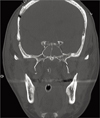Abstract
We report a case of penetrating injury of optic chiasm caused by severe head injury. Direct injury to the anatomically privileged optic chiasm is relatively rare complication. A 67-year-old male suffered a blunt head injury due to a fall accident. He complained total blindness of both eyes. Computed tomography (CT) revealed fracture of planum sphenoidale and the bone fragment which seems to compress the optic chiasm. The patient was taken to the operating room emergently for a intracranial decompression of the optic chiasm. Postoperatively, we performed a high-dose steroid therapy. The patient required prolonged hospitalization followed by transfer to a rehabilitation facility. Two months after the accident, the patient underwent a neuroophthalmologic evaluation. At that time, he was still blind in both eyes. On visual evoked potential (VEP), no evoked potential was noted.
Figures and Tables
FIGURE 2
Computed tomography revealed fracture of planum sphenoidale (A) and the bone fragment (arrow) which seems to compress the optic chiasm (B).

References
1. Braughler JM, Hall ED. Current application of "high-dose" steroid therapy for CNS injury. A pharmacological perspective. J Neurosurg. 1985; 62:806–810.
2. Cook MW, Levin LA, Joseph MP, Pinczower EF. Traumatic optic neuropathy. A meta-analysis. Arch Otolaryngol Head Neck Surg. 1996; 122:389–392.

3. Hassan A, Crompton JL, Sandhu A. Traumatic chiasmal syndrome: a series of 19 patients. Clin Experiment Ophthalmol. 2002; 30:273–280.

4. Kline LB, Morawetz RB, Swaid SN. Indirect injury of the optic nerve. Neurosurgery. 1984; 14:756–764.

5. Levin LA, Beck RW, Joseph MP, Seiff S, Kraker R. The treatment of traumatic optic neuropathy: the International Optic Nerve Trauma Study. Ophthalmology. 1999; 106:1268–1277.
6. Levin LA, Joseph MP, Rizzo JF 3rd, Lessell S. Optic canal decompression in indirect optic nerve trauma. Ophthalmology. 1994; 101:566–569.

7. Liu J, Ma Z, Liang Y. [A pathological study on indirect optic nerve injury in rabbit eyes.]. Zhonghua Yan Ke Za Zhi. 1999; 35:437–439. 427
9. Venable HP, Wilson S, Allan WC, Prensky AL. Total blindness after trivial frontal head trauma: bilateral indirect optic nerve injury. Neurology. 1978; 28:1066–1068.
11. Spoor TC, Hartel WC, Lensink DB, Wilkinson MJ. Treatment of traumatic optic neuropathy with corticosteroids. Am J Ophthalmol. 1990; 110:665–669.





 PDF
PDF ePub
ePub Citation
Citation Print
Print





 XML Download
XML Download